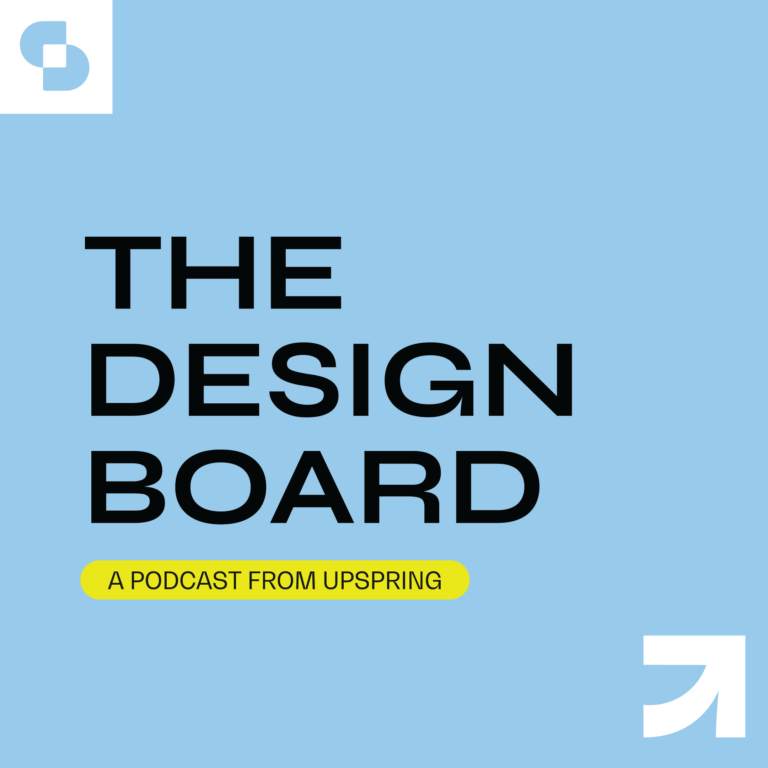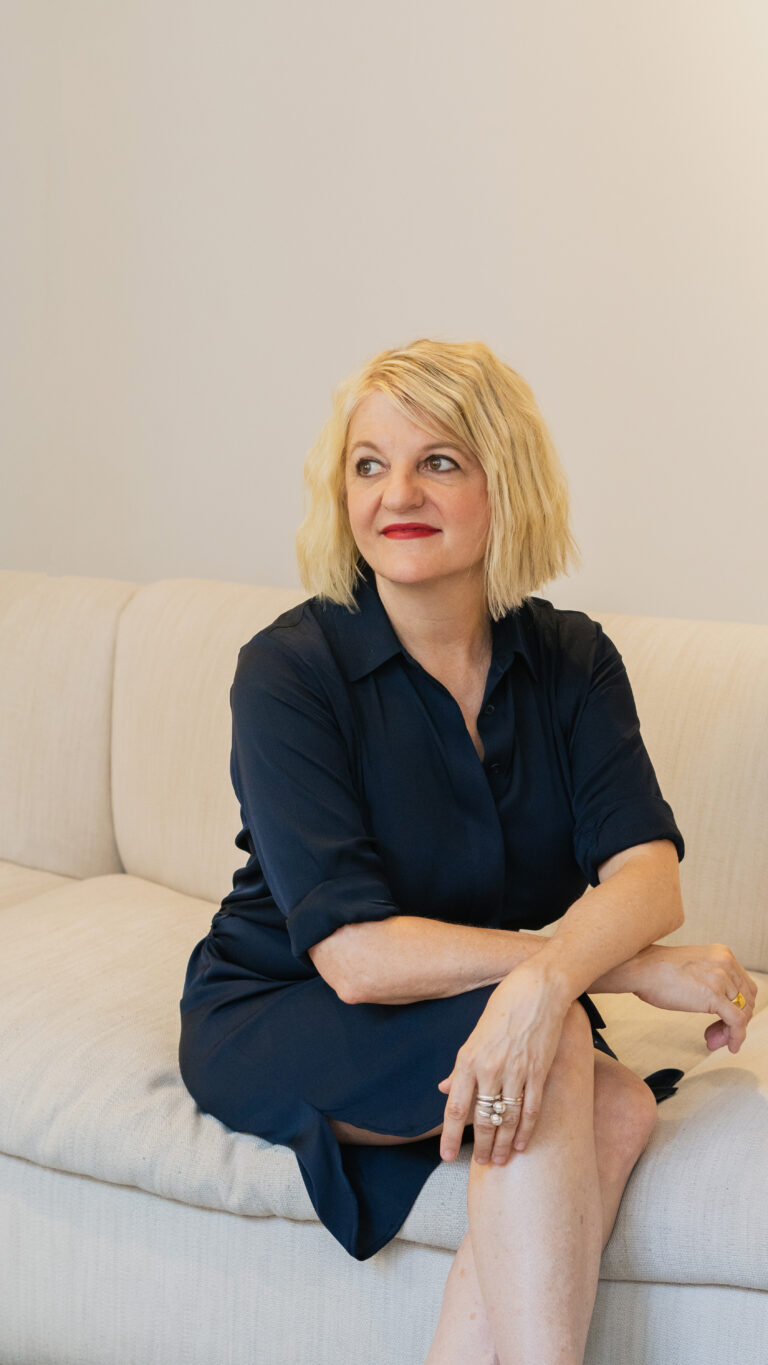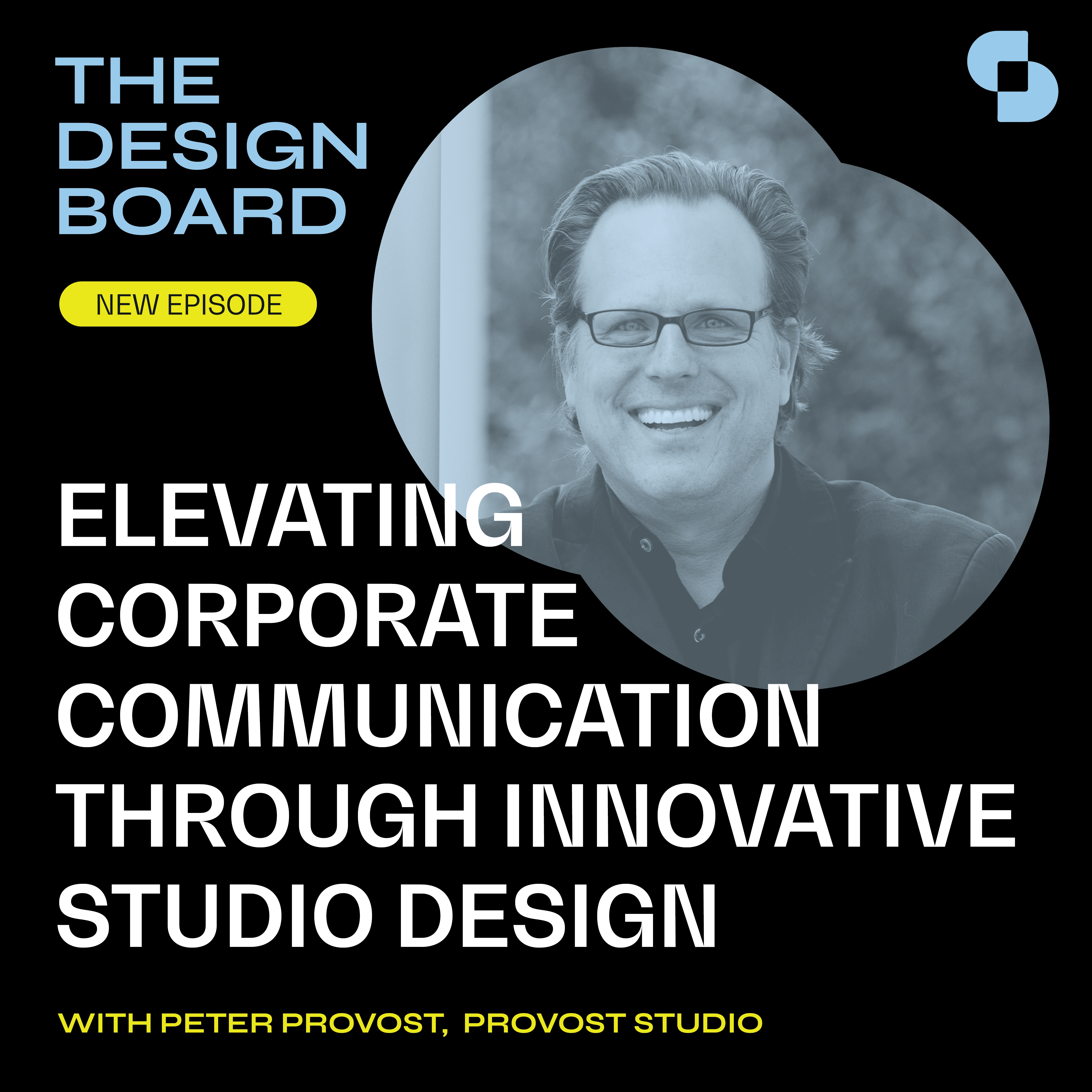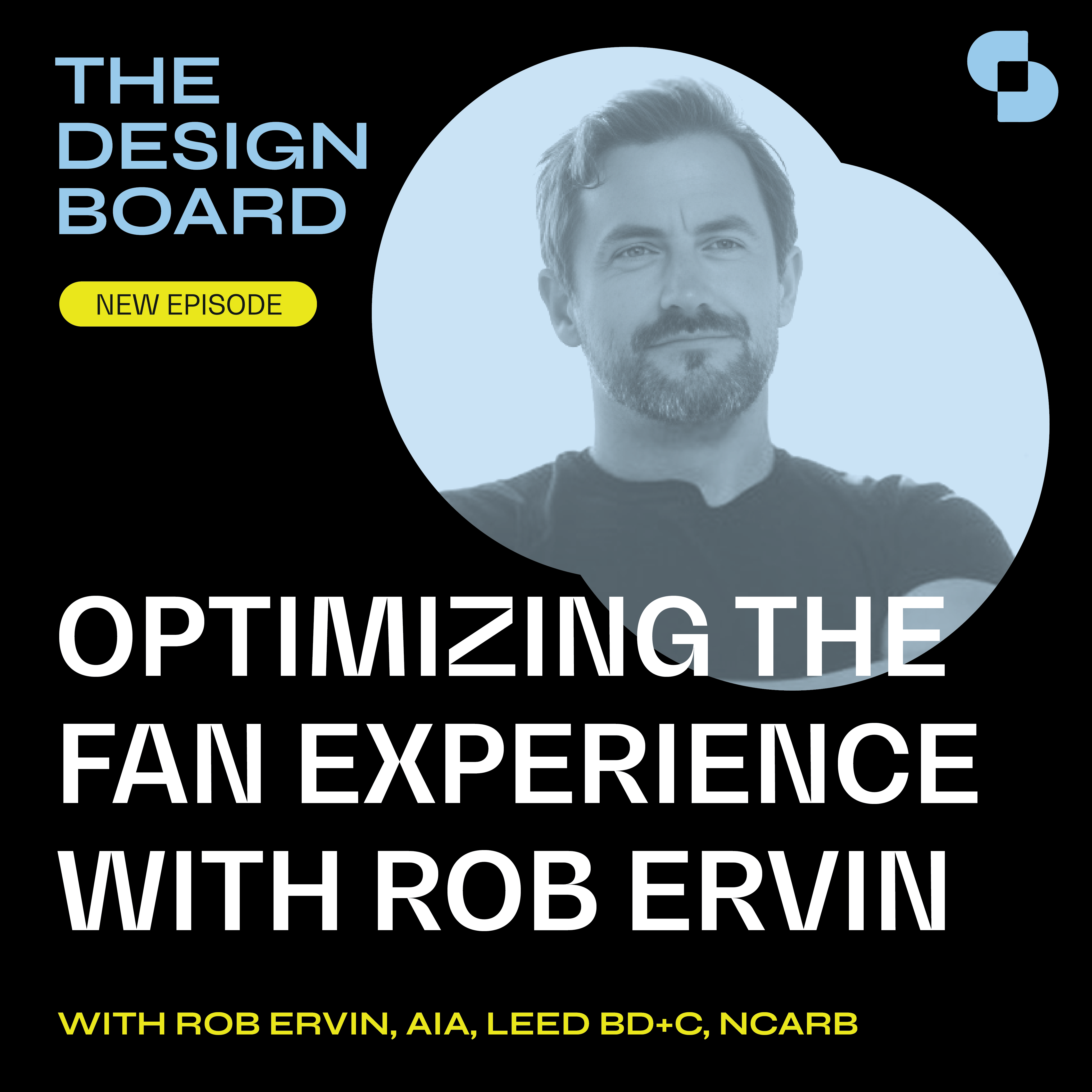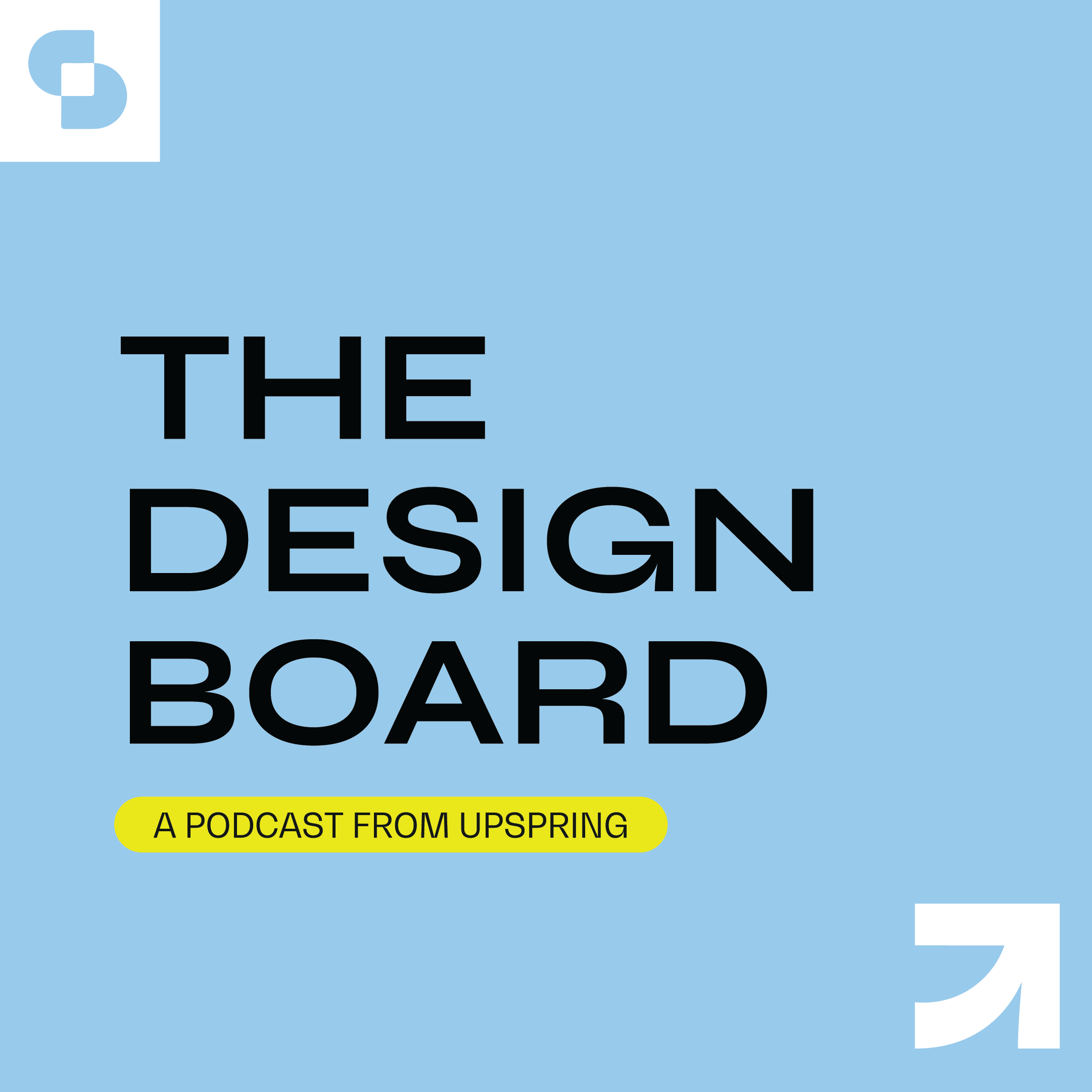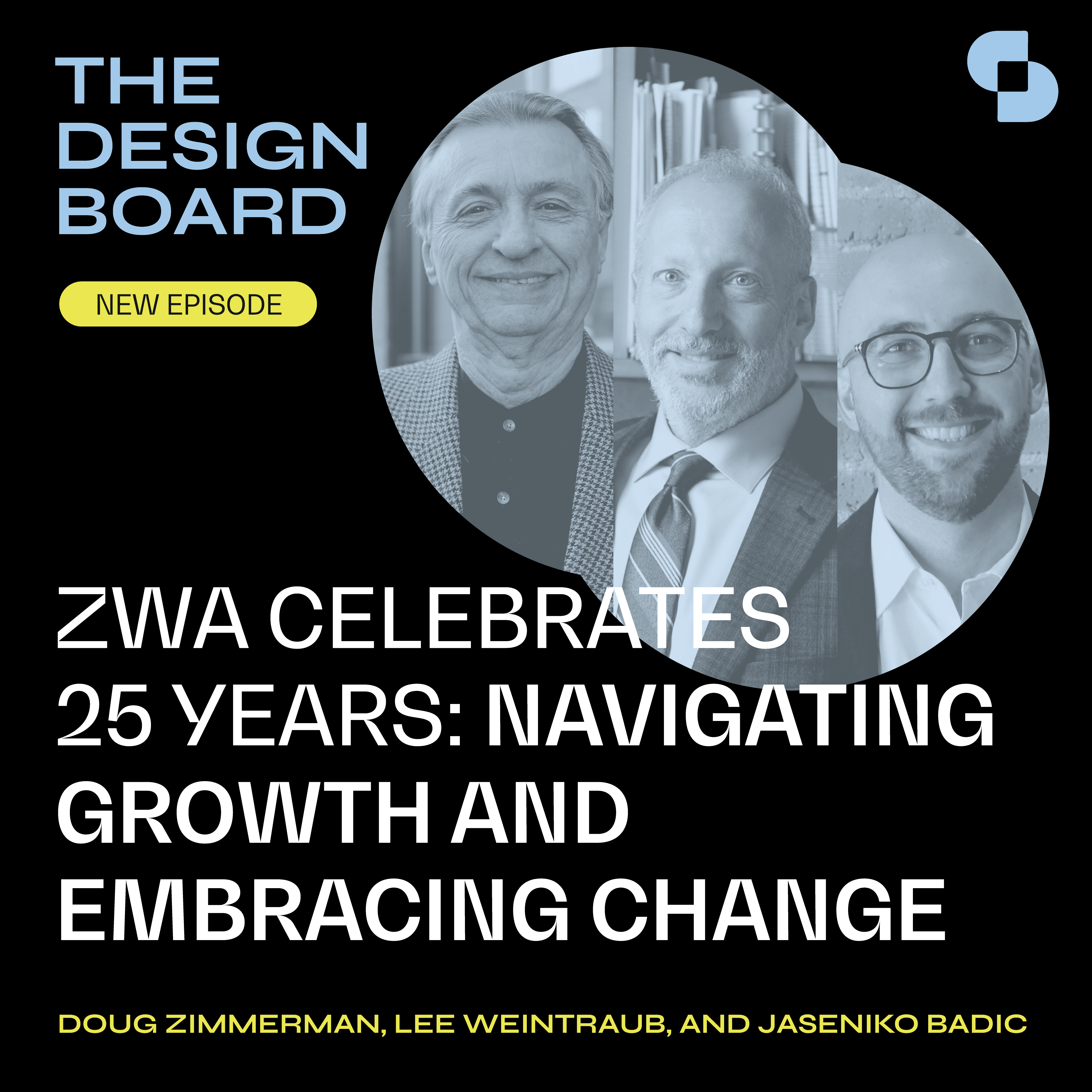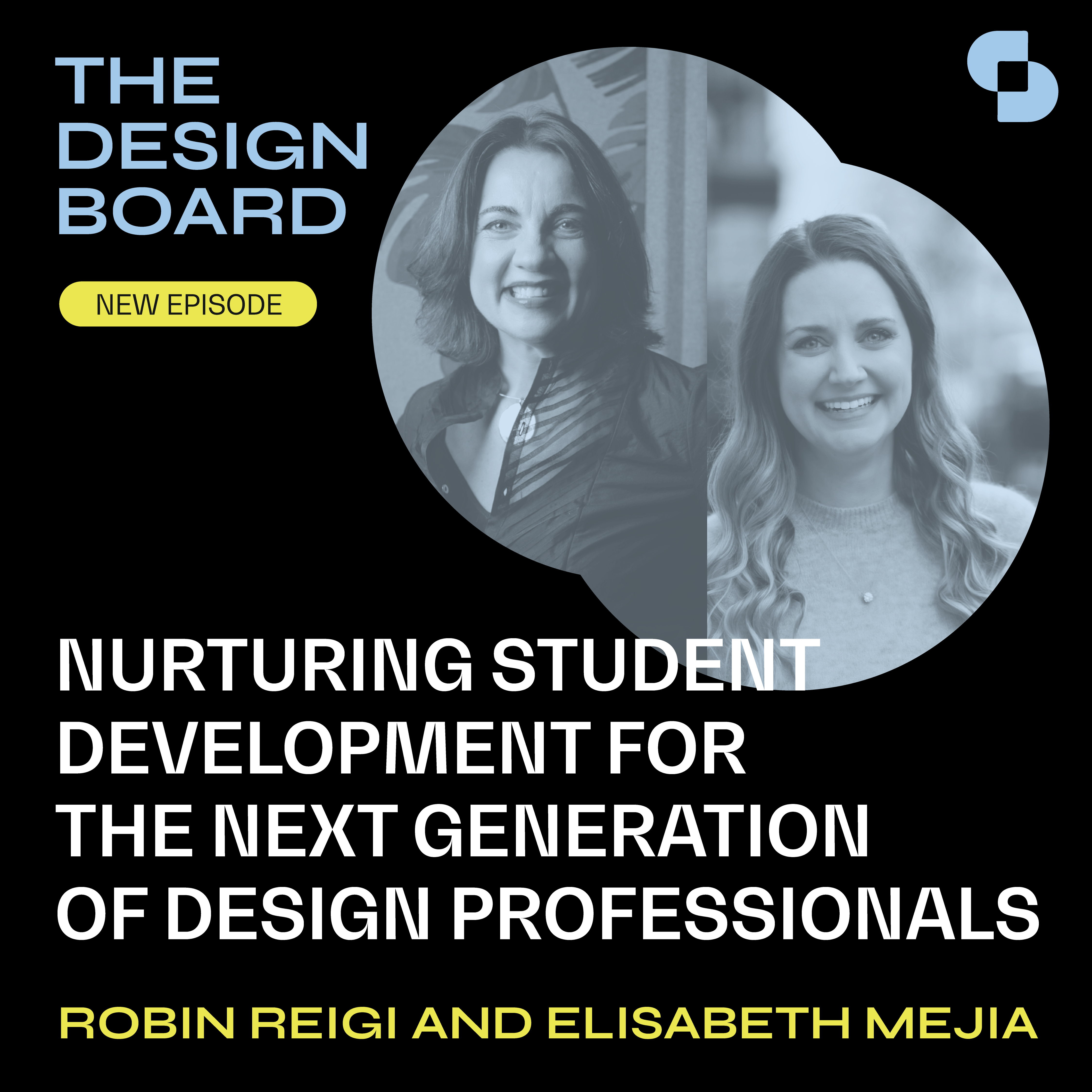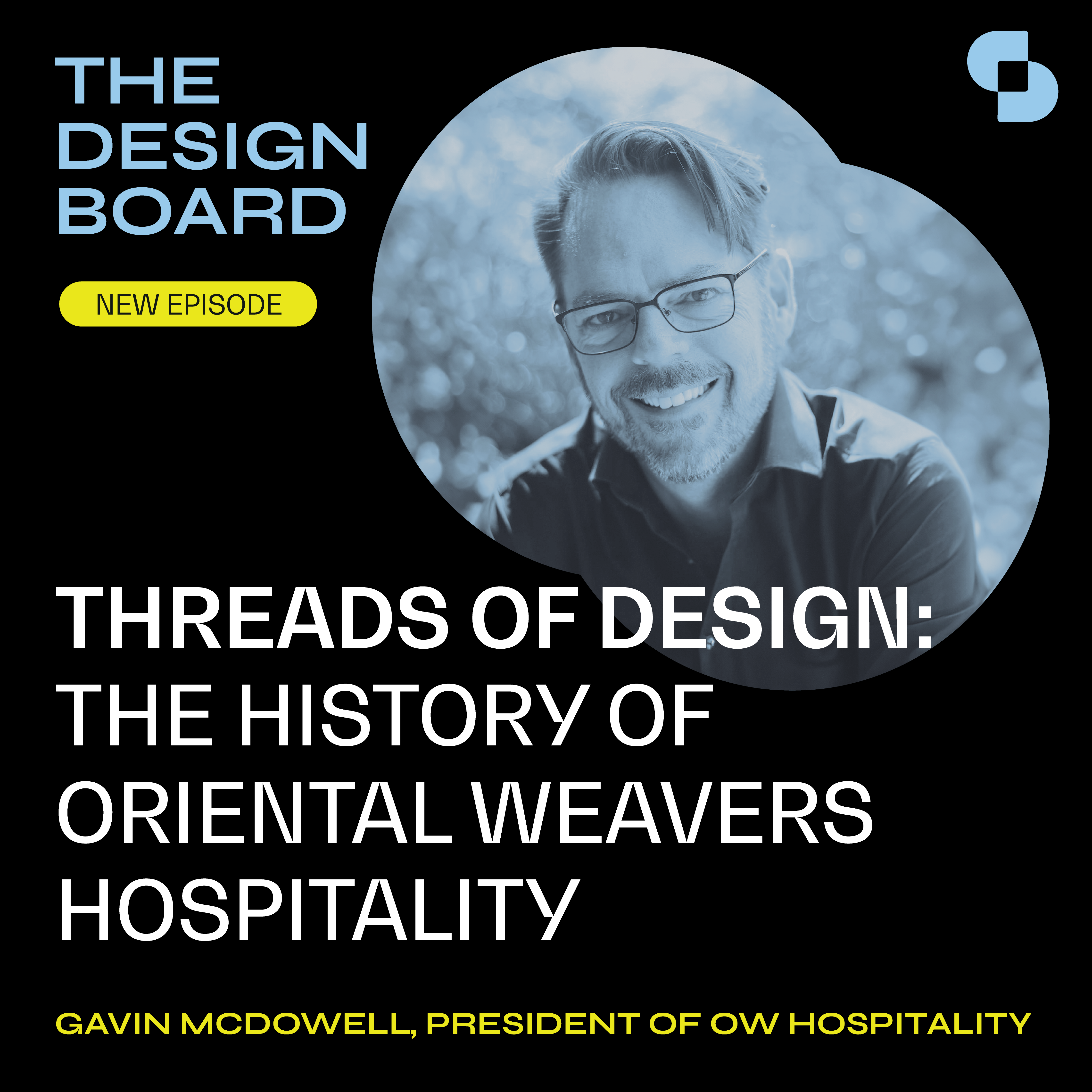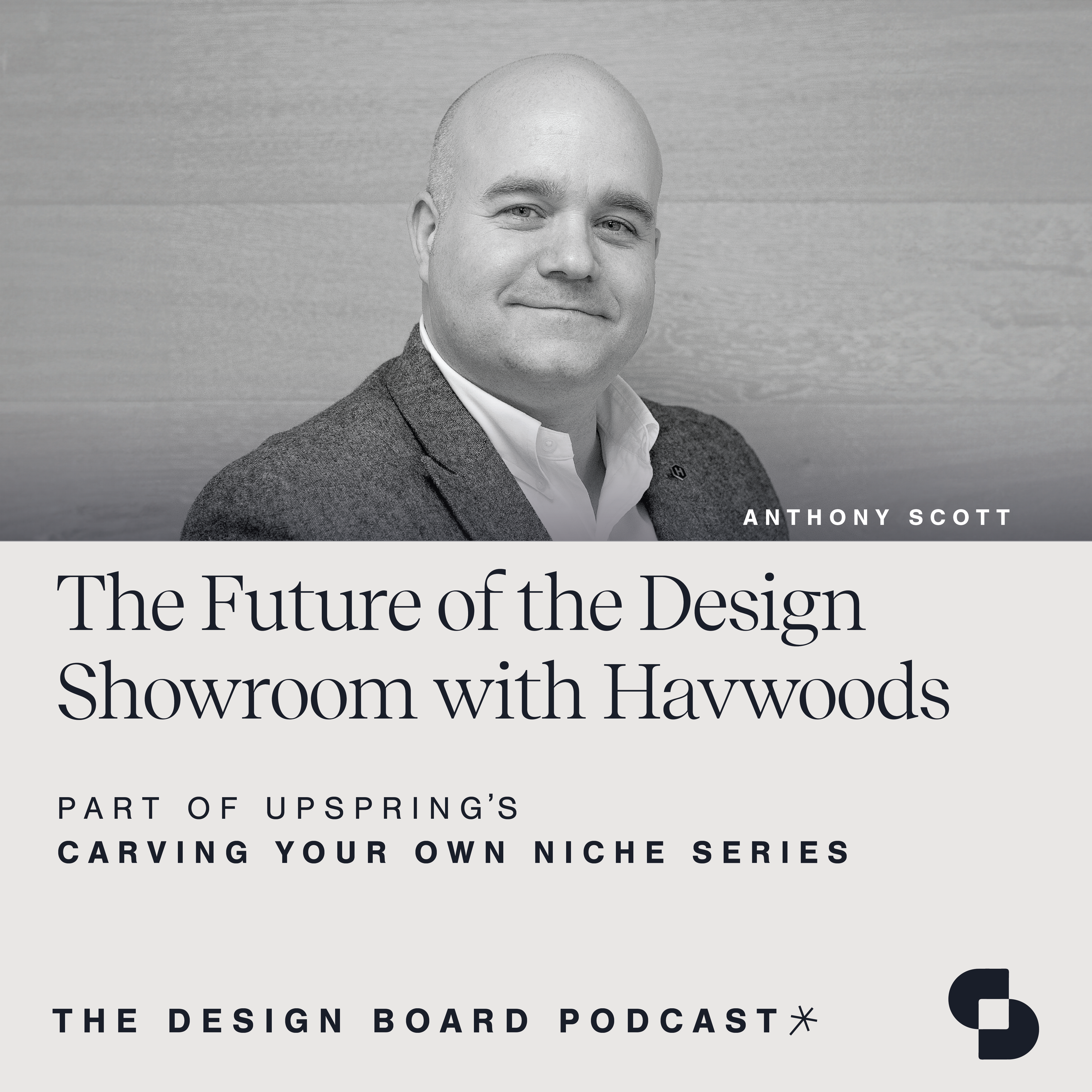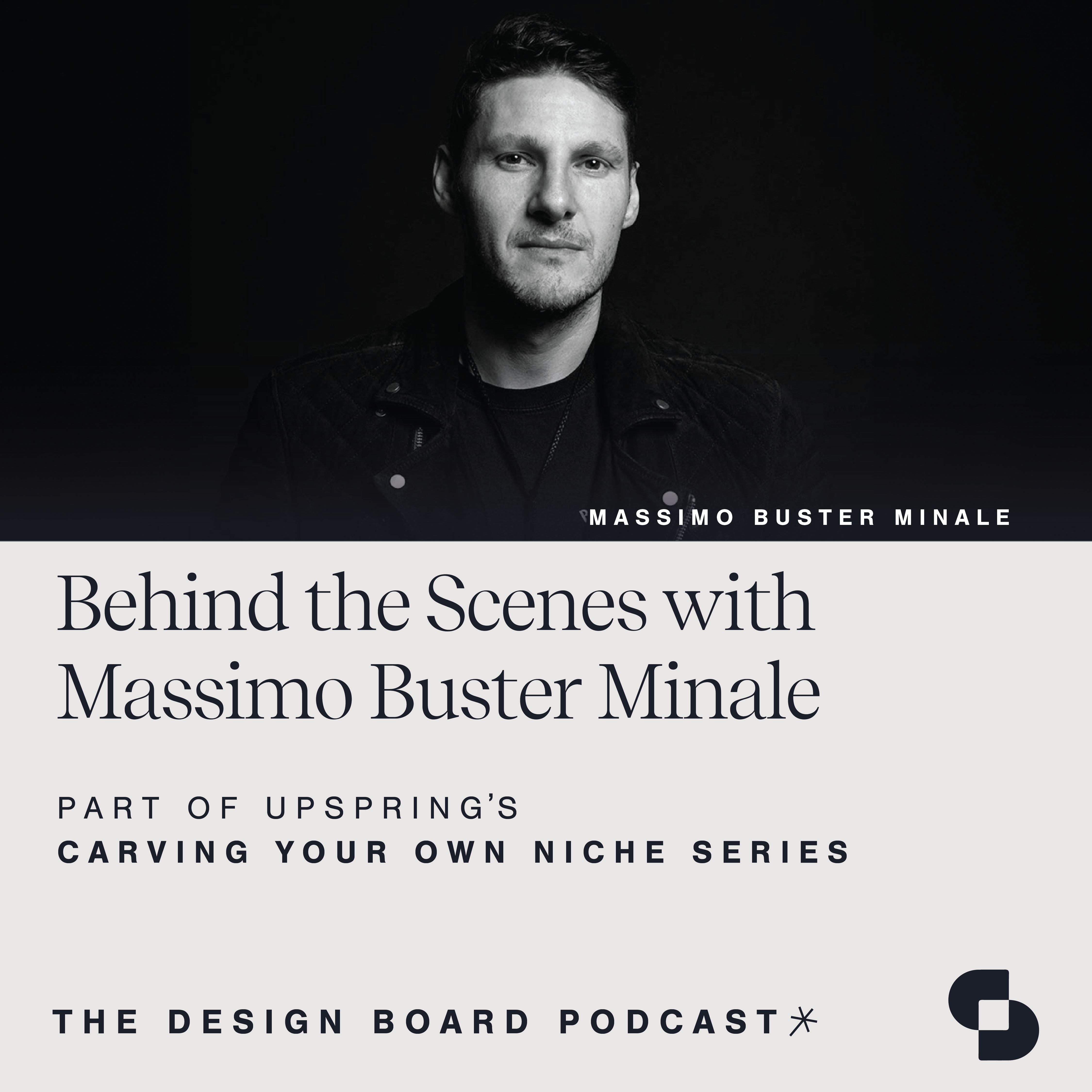Specifying sustainable products in the built environment is an important step in reducing the carbon footprint of buildings. In this episode, host Susan Fernandez is joined by Phanos Hadjikyriakou, Co-Founder and CEO of 2050 Materials, and Ana Rita Martins, Sustainability Senior Associate at Woodalls Design, for a lively discussion on third-party certifications, resources available for designers, and the best methods for choosing products that contribute to creating a climate-positive world.
Speaker 1: Welcome to The Design Board, a podcast created by the team at UpSpring that focuses on design, development and everything in between. We invite innovators in our industry and explore topics that support your growth in every way. The Design Board is a proud member of Surround, a podcast network from Sandow Design Group featuring the architecture and design industry’s premier shows. Check it out at surroundpodcasts.com.
Susan Fernandez: Hi everyone. I’m Susan Fernandez, vice president of digital marketing at UpSpring. We are a PR and digital marketing agency dedicated to the design industry. The built environment generates 40% of annual global CO2 emissions and how we build and what we build with will play a major role in creating a climate positive world. I’m joined today by two people who are on the forefront of truly sustainable change in the built environment. My first guest is Phanos Hadjikyriakou, co-founder and CEO of 2050 Materials. 2050 Materials is a technology company offering a library of sustainable materials and tools for the design and construction industry globally. In the past, he led an international team of climate researchers who advised real estate investors on how to manage the climate risks and opportunities related to their portfolios, as well as how to align their investment strategies with global climate targets.
I am also joined by Ana Rita Martins, a sustainability senior associate at Woodalls Design. Ana Rita, an accomplished architect based in London, is deeply committed to promoting ESG design and methodologies. Ana Rita heads the sustainability for Woodalls Design, a UK workplace design and build company. She has extensive experience in BREEAM, LEED, and WELL. Apart from her professional pursuits, Ana Rita participates in research and climate awareness groups such as the Sustainable Design Collective and UK Interior Design Declares. She is a highly regarded speaker at industry events and shares her expertise by mentoring students. Welcome both of you to the show. We’re so glad you’re here.
Phanos Hadjikyr…: Thank you.
Susan Fernandez: This is an expansive topic and something manufacturers and designers are still feeling their way through. I think it’s one of the hottest topics out there. It’s also one of the least understood, and as they say, the road to hell is paved with good intentions. It seems like there’s a lot of greenwashing, a lot of confusion, a lot of really great attempts when people are starting the design work, but it may not make it all the way to the install, so it is really difficult to understand what is happening in this very quickly shifting landscape. I’d like to start with you, Ana Rita. You’re a pioneer, I would say. Can you tell us about your journey from architect to sustainability senior associate and what that means?
Ana Rita Martin…: Thank you, Susan. Thank you for the invite. It’s really good to be here talking about this topic. I think it’s been a very exciting journey so far. I always started with this really deep interest around human-centric design and how spaces were connected to recovery or regeneration. With a lot of research and through evidence-based design, the connection with biophilia and nature, with people, I also was quite aware that the biodiversity loss could compromise what is actually essential to humans. Without earth, we actually cannot exist. Very luckily, I was really involved with a lot of big complex commercial projects that they had certifications that were environmental or social assessed such as LEEDs, BREEAM or WELL, and really quickly understood that was a lack of knowledge at the time, and the actions were actually seen as a tick in a box or badges and a lot of things that actually had a great impact in the environment, like green roofs, blue roofs, heat pumps, were almost like a card game with the value engineer process.
Take this, put that, and there was no actually control on a truly environmental impact. So the fact that I was involved with this project and also learning that concept quite often doesn’t pass to reality to sites and that actually, environmental control was not being delivered into a lot of these projects, I think that’s what attracted me to jump into my current role. I now lead a sustainability department of Woodalls, which is design and build company, which really means that under the same umbrella, we have design teams and also construction teams, cost teams, technical teams, and this means that we could have a seamless coordination of the ESG control, which is what I bring to the table, is being passed from concept to reality.
Susan Fernandez: I understand that in theory. Can you walk us through what that looks like on a project?
Ana Rita Martin…: Yes. So I usually say I actually have a lot of hats and I think that’s a very strong benefit of my career. I am an architect and I’m also creative, but on the top of everything, I am an environmental ESG expert. I think this word of expert is actually quite interesting because in this field, this is a continuous learning and we are dealing with unprecedented climate scenarios. Only now, we hear clients think about this as their business risks and roles like mine are happening as well just now. The way that I would divide a little bit of my role will be, first of all, I’m highly involved in projects, so understanding what’s the concepts and ESG goals, how we obviously accommodate and make the budgets and resource for that work, bringing the right experts to the table, capturing data and create a craft ESG roadmap for each client workplace, but that second point is how do we actually make the bridge of our methodology to reality, as I mentioned to you, and how is that applied to our sites?
What actually is going from the concept to the reality? I’m quite involved as well with our own company journey on mitigating our carbon footprint, of assessing where we stand and how can we reduce and create a roadmap and to become a more mindful business. As you mentioned as well, I think there’s been a big part of me that speaking in public or even educating, it’s so important because this awareness that companies just like us are on a journey, it’s about transparency and you hear a lot of words such as net-zero, carbon-neutral, but what’s important is starting to assess and create a roadmap to reduce and learning from others. Silo works are not really taking us in anywhere and collaboration is definitely what the industry needs at the moment.
Susan Fernandez: You’ve mentioned ESG or environmental, social and corporate governance as an emerging topic. Can you tell us what it is and how it shapes what you do?
Ana Rita Martin…: Sure. Let’s start by ESG, which is a framework or a set of standards that measures business impact on society or organizations around environmental social issues. The reason that is really important for the work that we do is because we know about this big percentage, but I’m going to say again. The construction industry creates globally 40% of the carbon emissions. I think that means that obviously, designers and constructors, contractor, all of this industry has a big environmental impact. Another part is because we create fit-out workplace. This means that it is actually a quite invisible part of this industry, because in a lifespan, if you think about it, there is the building, let’s say 60 years. There’s going to happen a lot of tenancies over time in commercial buildings. Actually, there is recent data that shows that after COVID, tenancy works, which is the fit-out in a commercial environment, could happen from two to three years.
If you imagine over the time how many times that’s happening, you can really calculate that the carbon emissions will be very, very big compared to just the lifespan of the building. This means that it’s the invisible part of this industry that needs to be tackled, needs to be assessed. Not only that, the industry doesn’t only have a big impact on biodiversity, but also in human value. If you think about the enormous big supply chain and talking about ethical sourcing or illegal labor control, it’s really, really important. On top of that, we also create workplace, which is ultimately where people spend a lot of time and should create as well the best work. Focus on health and wellbeing in order to create high standards of productivity levels, retention and attracting talent. It’s a big part of that social value as well.
Susan Fernandez: That is really interesting. I love that measuring this idea of wellbeing has become something that has translated to the built environment. It is really interesting. The first time I think… It was pre-pandemic, so three years ago, I was at Marriott and I had a client there and it was the first time I’ve ever seen a design team pick up an object and say, “Well, who made this? How did it come out of the earth? What is it going to do while it’s in the room and where is it going to go when it dies?” That was the first time I thought, oh, things are really changing and manufacturers need to keep up.
I think hearing all of this from Ana Rita, so you are on our… What a lot of our clients are either going to add a sustainability person to their roster if they’re a design firm or we have manufacturers that want to market to folks like you and Phanos, that’s really where you come in because you’re almost on the other side or acting like the translator. Reading your CV was absolutely enlightening. I’ve always known of your focus on materials. I actually had no idea that you were an advisor to real estate investors, helping them reduce risks from climate change. Can you tell us about your journey from advisor to CEO?
Phanos Hadjikyr…: Yeah, first of all, thanks for having me here as well. It’s super nice to be on this podcast. My journey started… I studied environmental engineering, so I’m a data person by background, but then I found myself almost by mistake in this investment space where I joined the startup initially building models to try to model the risk of climate change on specific stocks and then later on, on actual real estate portfolios. Coming from the data side, I was interested in the technical problem around this. So basically, how do you take changes in the regulatory environment and changes in weather events and translate them or project them onto, for example, a building. Essentially, that’s what brought me to work with investors in climate risk and uncovered another passion of mine, which I initially did not know about so much, which is simplifying sustainability data for a specific stakeholder in a format that allows them to actually take action and not just look at the data without much to do with it.
That’s a little bit of how I started working in this space and the journey from my previous job to what we’re building today at 2050 Materials started when I was working with large real estate investors and they were talking about supply chain risks and scope three emissions, so everything essentially that relates to the materiality of the building. That spiked a particular interest in me because I come from a background or a family background of architects, designers, and also people working in distribution of building materials. When I saw those demands by the clients, I reached out to the people close to me and to friends to see whether the actual, let’s say, real economy as the financial specialists call it have the right kind of tools and data to deliver on the client’s targets. What we realized very quickly, and I’m sure Ana Rita can probably vouch because she was one of the first people we reached out to get real industry insight, is that there’s a lack of data as well as a lack of an understanding of that data.
So there’s a very large amount of complexity around things like environmental product declarations or lifecycle assessments or health product declarations. There’s also just a problem in the process of extracting and getting access to that data, so basically, that’s the main driver behind what 2050 Materials is doing. If I were to summarize it into a very short sentence we like to say a lot because it’s really what drives us, is we are trying to democratize data-driven decisions from the designer’s perspective. We’re building a tool that is friendly to designers, it looks nice, it fits their processes, but always having in the background the real environmental data and the environmental impacts of the decisions that you’re taking.
Susan Fernandez: I love that. That’s really cool. I love the idea of democratizing data. Tell me, how do manufacturers become a part of this? Do they have to apply for you to look into this? How are you getting all this data? Who is giving it to you? From where we sit in America, you are way far ahead of what our typical manufacturers could ever even dream of providing. How do they become a part of this?
Phanos Hadjikyr…: So generally speaking, at 2050 Materials, we do a lot of work of collecting and centralizing already publicly available data. Anything that already sits somewhere on the internet in some sort of PDF or Excel file is something we want to have on our platform. A lot of that work happens by our team to onboard the library and usually, manufacturers contact us after they’ve already had some level of their data already published, and they start seeing the value in having these product pages with harmonized centralized data. The interesting thing about the industry, which I also did not realize before really diving into it, is that while you would expect that manufacturers have good ownership of all of this data, in reality, when you ask them to provide you, let’s say, with all of their data sheets, environmental product declarations, any sort of other certifications they might have, you usually get no answer.
Not because they don’t want to share them, but simply because they sometimes don’t exactly know where those documents are stored and what document corresponds to which product. In a way, of course we add value to the design industry by democratizing this data, but we indirectly, in the process of doing that, add a lot of value to manufacturers by just harmonizing that information. When they start seeing that value, they can very easily get onboarded on the platform. Usually they reach out to us through the platform support pages, and then we quickly give them access.
Susan Fernandez: That’s very interesting. I think that is really in line with what we see here, that there is that disconnect. So you’re looking at the data all the time. Well, first of all, what exactly is it telling you? Are manufacturers in line with what our goals for a climate positive world are? Are they creating products that are going to make Ana Rita very happy to specify and install? Second part of my question is, is the data showing you anything that you hadn’t expected? If so, what is that?
Phanos Hadjikyr…: Yeah, those are all very good questions. I would say that the first thing we are seeing is something that makes me personally very optimistic. We live in a state of constant research at 2050 Materials to discover new products, alternative products, more sustainable products. The very nice thing that we are seeing because of that position we have in the industry is that there’s continuously new manufacturers, startups, innovations within larger companies that are starting to cater to the low carbon and sustainable construction sector that we are supposed to be building towards. That’s the very first thing I would say we see. As to the second question you asked, Susan, of whether the industry is already where it needs to be, I think it’s a tricky question.
I would say that there’s a large amount of products from… At least from the data perspective, there’s a large amount of products that can be used to deliver more sustainable buildings, more circular buildings. However, I would not say that that’s the majority of available products, of course. I think what we are seeing is that there’s a huge push towards scaling the manufacturing and the production of these better products. Hopefully, designers like Ana Rita are prioritizing those products when they come, when it’s within the project budgets and constraints, and those products will eventually take the lead in terms of what is used mostly in the industry.
Susan Fernandez: Thank you. So Ana Rita, coming back to your perspective, can you walk me through how you find and vet products, and this is a multi-layer question, so how do products get into your awareness set? Are there other resources, websites, associations that you use? Just take us through how you find out about new products and vet them.
Ana Rita Martin…: I think, Susan, this is the golden question at the moment. What I like most of it is there’s not a right answer or a clear equation. We need to start by creating a specific strategy for each client workplace and deconstructing what ESG means for each client and also what they want to claim at the end of the project. I think that must be really defined at the beginning, so we create dedicated workshops to really understand what kind of specification and even goals will be applied to the project itself. Only then, we can create the right specification and aligned with the budget and those goals. There’s a lot of focus that the specification could have, like Phanos mentioned, low carbon, high recycle content, low water use, vegan specification, health focus, ethical sourcing. Because you have so many different directions, what we do is really, after creating these dedicated workshops with clients, we really deconstruct this in three main pillars.
So I call them the ESG pillars, which is the first one, it’s environment, second, wellbeing, third, health, and fourth, social. Only then we can really create what is the different strategy. If there’s need… Certain certification or assessment or specific parameters for each of these pillars, and then the specification will be crafted around this. Only then we can create the right strategy and then measuring these goals during the project timeline in delivery, but what I would say, and there’s such an important point, is we are also the experts of workplace on this. Quite often, clients don’t demand enough commitment to ESG. It is important that we advise the clients that there is the best practice for specification and there is a risk if you do not tackle ESG. We do still put always on the table things that we consider that they are highly important, like low VOCs, which could be toxic for the indoor air quality, low carbon. That is something that is a quite important point we could also advise and push back to be quite more ambitious.
Susan Fernandez: That is really fascinating. I love that you had divided up into pillars because that makes it very clear on how you are doing your evaluation. What other certifications, information and samples or just exactly what do you need to make a sustainable specification?
Ana Rita Martin…: So I’ll start by saying that in the fit-out world and also construction world, there is not one platform that could do it all around ESG. I think, like Phanos mentioned, platforms like 2050 Materials have such a great potential because this is about educating every designer or team member. I think sometimes, there is lack of time to create a due diligence around materials. It’s impossible that we can just know all certifications or information, so creating a library that applies parameters or filters is really important, but at the moment, what we see is a lot of silo work. A lot of practices have their own internal libraries. We have a library ourselves where we are trying to have this kind of information about environmental and social, and it’s like understanding that if we do have an open source as there are at the moment, open sources around supplier questionnaires, and also these filters and parameters, so I’ll start with the biggest myth, which is a certification or an EPD, which is the environmental product declaration with carbon data, doesn’t actually make any material or element sustainable or low carbon.
I think this is so important to understand because at the moment, we are surrounded by every supplier has a green or ecolabel, and I think what’s important to understand is a product that is assessed by a third party, you just have to be able to read the information and if it’s aligned with the right ESG parameters. If that’s not possible on the designer’s side due to lack of knowledge, expertise or time, it’s very important that you involve the right experts or consultants into this process, but yeah, I think the part that it needs to be transparent and labels are just an important part of this kind of systemization on the specification. There’s many labels, as I mentioned before. You have low VOCs, EPDs. There’s the clear label, which it’s still not very common in Europe, but there’s such an important idea behind which is disclose the ingredients of materials. I think that’s a fantastic idea that should be more out there. We actually can read what’s the toxic materials within the elements of all the products that we use, but I think that’s the important part, is understanding how to deconstruct also the certifications.
Susan Fernandez: Thank you. Phanos, what advice would you give a manufacturer who wants to bring a product to market and specifically who wants to market a product to someone like Ana Rita? Can you tell me what they need and how you would suggest they move forward?
Phanos Hadjikyr…: Sure. What we see, and this is not my personal opinion, but what we see from specifiers we work with, designers we talk to daily, is that what really matters from a manufacturer’s perspective today is to prioritize transparency, not just the efforts to be sustainable. What that means is if you really want a designer to start trusting the marketing efforts that you’re doing and to build a relationship with a specifier or with a designer, the most important thing is to make them feel like you’re not trying to cheat them through marketing messages. In the context of sustainability, that often means, of course, getting some certifications when it’s possible.
Anything you can get certified, and especially if you can get certified using third party verifications and things like that, that’s all great, but really, the main thing I would say we see from our perspective is don’t try to hide data. Eventually, the performance of your products will be researched either manually or through some way by the designer and they will uncover the real performance of the product. It goes a long way to be honest and transparent about that performance, let’s say, from a sustainability perspective, and to help the designer in the process of deciding whether it’s the right material for them.
Susan Fernandez: That’s interesting. I’m guessing that there’s a collaboration there between… I think a lot of designers could advise manufacturers on exactly what they need, I’m guessing. Ana Rita does that quite a bit, but that’s very interesting. Going back to you, Ana Rita, we all know it’s great to specify sustainable products, but how do we ensure they’re not substituted or value engineered out and that critical installation processes are being followed because ultimately, you can make really smart decisions, but when it comes down to the install, if it gets substituted or the system isn’t set up correctly, it’s all for nothing.
Ana Rita Martin…: I think that’s a great question. That’s one of the reasons a few years ago why I change industries, because somehow, for me, it was very important to see what the design concept was actually happens into the reality as I explained and almost create this seamless approach that in the end, it’s all about responsibility and lock it with the right parties. Myself, I wanted to be involved in the design, but actually how that is then applied to sites and then how also the data is captured after. I quite often think that we do projects, it’s a dot in time, but then the projects that you create, they’re going to stay there over the years, and I’ve always been very interested again, how does space impact people? If we think about when the budget is not that healthy, you need to make sure that this swap needs to be controlled. Sometimes it’s fast timelines. Other times, there’s really long timelines.
In architecture world, it could be many years and it could get diluted. In order to not lower environmental specification due to value engineering or time or again, knowledge, it’s very important that we make sure that this is captured, costed, and agreed with the clients. This control could be through… In a traditional design, now it’s getting better because it’s going to be delivered by someone else, the contractor side. You need to make sure that you’re detailing your specification documents around ESG, and you have clauses that really restrict the substitutions around sustainability. Not only aesthetic, not only costs. I think that’s one of the advantages of our methodology, is there’s a clear communication in a seamless way what we deliver, but I always find it’s very important that there is certification or assessment that’s been agreed in the beginning, so you could just make sure that nothing is swapped around the ESG.
Susan Fernandez: It sounds like you do a lot of client education, Ana Rita, and a lot of selling to the client, once you educate them, the value and the diligence to seeing this through to the end install. Okay, this is a question for both of you. I’m going to start with you, Ana Rita. What is missing from the market, be it a product, material or resource that would make confidently specifying sustainably easier for you?
Ana Rita Martin…: So the first point would be definitely on a broad architectural sense. There is definitely missing this lifecycle assessment involvement with the specification itself and obviously, how do we control the carbon footprint of our projects? It’s important that that is covered, not only the embodied carbon, which is the materials that we are going to incorporate and bring to the project, but also the end of life of these materials, what is going to happen. That’s the first point. The second one, furniture is at the moment really lacking information and data and there is often no carbon data. The certifications or eco-information is lacking. This is a big part of the fit-out world and the commercial industry and the fact that it’s not really covered, it’s really missing. The third point is frameworks around health and how do we measure health? How do we understand the impact on health and the users of the spaces and ethical sourcing? How do we also control that over the supply chain and make sure we’re protecting the safety of workers in producing these materials.
Susan Fernandez: Thank you. How about you, Phanos? What do you think needs to happen here?
Phanos Hadjikyr…: From my perspective, we have pretty amazing innovation happening from the technological standpoint. We’ve all seen things like ChatGPT, and all of the pretty insane things that AI can do. What’s missing in my opinion is let’s apply all of that amazing new technology to real problems that have real impact. I think all of the things that Ana Rita mentioned around not just the carbon of our designs and our buildings, but also the health aspects, the livelihood aspects of what we’re designing, I think it would be amazing if we had more technology leaders and entrepreneurs and anyone working on solutions really focused on this absolutely critical topic.
Susan Fernandez: Thank you so much. This has been fascinating. I just have a couple last questions. Where do you, Ana Rita, see the industry heading? How will you approach design in the future? Really thinking about it, how is climate change going to affect your decisions?
Ana Rita Martin…: So I see, and at the moment, the industry is moving really fast and I believe that it’s heading to the right direction. It’s really crucial that there’s a clear tight path on this direction that organizations and legislation really align with the right goals. It’s not only the pressure on the clients, it must be around policies and coming from above, but also organizations and companies like us need to be all starting this journey. What really keeps me going is that to really tackle climate crisis, there is this need of collaboration, people working together in order to make sure we shift the industry to the right direction. I feel that there’s this beautiful way of designing in a future that is not only around this control on aesthetics, but we are always going to have also a budget control, but certainly, we have this environmental and social control that comes and merges since the beginning. We design always with aesthetic, profit and environmental side by sides as a core value in all designs. I think that’s basically… There’s no separation there. We design with earth and human at the center.
Susan Fernandez: Thank you. I love that idea. Sounds really beautiful and really promising. Phanos, I’m going to give you the last question. Tell us how you see 2050 Materials taking the industry in the next five years. This is a two part question. What do you see the changes being within your company to accommodate this new vision? How will you see it supporting the climate transition? I know we’ve talked a lot about transparency. I think manufacturers are going to be absolutely interested to be a part of 2050. Can you tell me where you see it going and what you think its impacts are going to be?
Phanos Hadjikyr…: Absolutely. On the first part of the question of how we are developing as a company, our core focus is to really capture every single data point that indicates the sustainability performance of building products out there. We’re doing that through multiple efforts in digitizing certifications, partnering with different organizations that do these assessments, as well as building tools on our platform to start estimating the footprint of things like furniture, which Ana Rita mentioned has a big gap in. That’s the work that we are planning on doing in the next years and the way we see ourselves supporting the industry. Basically, as I mentioned previously, it seems to us that all of the sustainability data around building products will need to flow from one stakeholder to the next, whether that’s a building owner, a designer, a contractor, or a manufacturer.
There’s going to be pretty impressive solutions, I think, that allow designers like Ana Rita to deliver actually sustainable buildings, but there’s also a somewhat ugly or less beautiful side to that, which is that we need structured data and we see ourselves as being really the data layer of the industry that’s able not just to offer the data through our platform, but to offer our data through an API into a bunch of other solutions. We are already starting to do that with some really innovative startups in the AI space as well as, I would say, more conventional software that estimates cost and now wants to have other parameters next to the estimation.
Susan Fernandez: That’s fascinating to think that sustainability is going to be such a data-driven decision, data transparency. Ana Rita, do you have any final thoughts?
Ana Rita Martin…: I think this is such an important point about having the right data because it’s really, really lacking at the moment. Making the right decisions is quite hard to navigate around this really complex world of ESG and as Phanos has been mentioning, when we do have the right data, then we can make sure we create the right impact on the environment, on people. Until then, we just have to be transparent about what we do. It’s a lessons learned process and really being surrounded by the right experts, it’s what we could do in order to make the right decisions.
Susan Fernandez: No pressure, Phanos. We’re counting on you for that data. Any final words from you?
Phanos Hadjikyr…: I guess from our side or from my side, my only call-out is one that Ana Rita and I both heard last week in an event we were at. It’s important to understand how much impact designers can have in the world through their job. I think it’s a disproportionate amount of impact compared to other jobs. My only call-out is if you are a designer, start looking into some of the solutions that are out there, at the data. Start seeing how offices like Woodalls of Ana Rita is really doing their jobs and register of course on our platform to see how you can make that process easier, but really start doing what you can because the impact is massive and we need as much impact as we can get.
Susan Fernandez: That’s fantastic. Thank you both so much for being here today. This is The Design Board, a podcast by UpSpring PR. You can reach us at upspringpr.com. Thank you so much for being here today.
Speaker 1: Thank you so much for listening in with us today. We hope you leave inspired by the ideas in today’s episode. For more, follow UpSpring on LinkedIn and Instagram. Don’t forget to check out the amazing lineup of shows brought to you by the Surround Podcast Network at surroundpodcasts.com.

